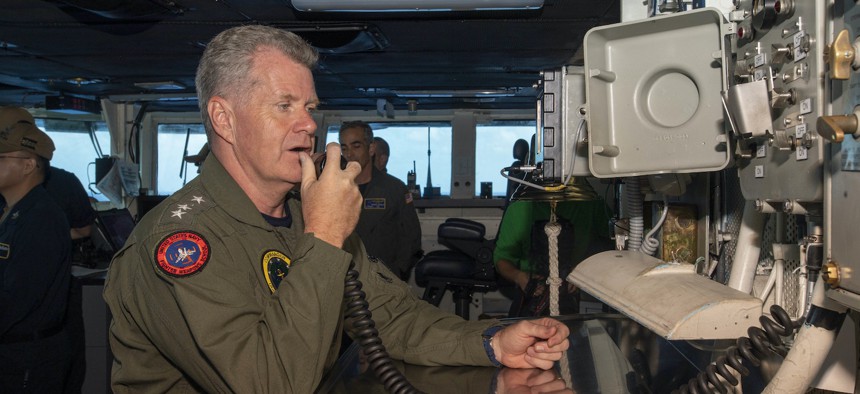
Adm. Samuel Paparo, commander of U.S. Pacific Fleet, speaks to the crew of the aircraft carrier USS Nimitz (CVN 68) over the ship’s public address system in 2023. U.S. Navy / Mass Communication Specialist 2nd Class Samuel Osborn
China is winning the shipbuilding numbers game—and that’s a problem, INDOPACOM nom says
“We are not overmatched, but I don't like the pace of the trajectory,” said Adm. Samuel Paparo, head of U.S. Pacific Fleet.
China’s military shipbuilding is outpacing the U.S., and while that doesn’t necessary spell defeat, the Biden administration’s pick to lead Indo-Pacific Command is concerned.
“The [People’s Liberation Army] navy has been on a historic trajectory these last 25 years, and while we are, I am, confident that we would prevail in combat,” Adm. Samuel Paparo, Jr., commander for U.S. Pacific Fleet, told senators Thursday. “We are not overmatched, but I don't like the pace of the trajectory.”
Paparo, testifying at his confirmation hearing to lead INDOPACOM, suggested that American military collaboration and U.S. tech like unmanned vehicles offsets the size of China’s fleet.
“We're a joint force that thinks in a multi-domain mindset. And that is the kind of formations in maritime terrain. Those are forces on land that can affect events at the maritime that can shoot, move, communicate and impose costs against the naval force to augment the Navy force at sea,” Paparo said. “And then further, the 21st-century capabilities, unmanned capabilities, from the seabed to the heavens.”
China’s Navy has 79 more ships than the U.S., said Sen. Dan Sullivan, R-Alaska, including 30 it added in the past year—half of which were large surface vessels.
China’s “rapid naval buildup has highlighted our own shipbuilding deficiencies,” Sullivan said. “Numerically, they now have a larger Navy, roughly 370 ships to our 291 ships. Last year, they added 30 ships to their fleet; 15 were large surface combatants including cruisers, destroyers and another aircraft carrier. We added two.”
The Defense Department has been increasingly focused on building up forces and capabilities in the Indo-Pacific region in preparation for a potential conflict with China.
Paparo said if he is confirmed, his top priority will be equipping Guam with an integrated air and missile defense system. Guam and the northern Mariana islands would face a “greater and direct” threat from China if it invades Taiwan, he said.
“A multi-layered, effective, capable, integrated air and missile defense system from the surface of the sea to the heavens to defend the 170,000 Americans in Guam, the American homeland—it would be my No. 1 priority if confirmed,” Paparo said.
The Pentagon is planning to spend billions on military construction on Guam through fiscal year 2028, including nearly $2 billion to build a missile defense system. One of the biggest challenges has been finding a good location.
When asked about quality and range concerns with the troubled KC-46 tanker, Paparo said he is more worried about joint force refueling capabilities.
“I'm not savvy on the precise range, and it's always a choice between how much gas it takes to get to the point where you're refueling and how much give there is at that point. But I am concerned about the joint force’s ability to refuel a dynamic force operating in the air,” Paparo said. “We've got to have a consistent critical eye.”




